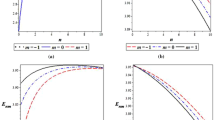The characteristic features of ortho- and para-helium are investigated within the framework of Relativistic Schrödinger Theory (RST). The emphasis lies on the conceptual level, where the geometric and physical properties of both RST field configurations are inspected in detail. From the geometric point of view, the striking feature consists in the splitting of the \(\mathfrak{u}(2)\)-valued bundle connection \(\mathcal{A}_{\mu}\) into an abelian electromagnetic part (organizing the electromagnetic interactions between the two electrons) and an exchange part, which is responsible for their exchange interactions. The electromagnetic interactions are mediated by the usual four-potentials A μ and thus are essentially the same for both types of field configurations, where naturally the electrostatic forces (described by the time component A 0 of A μ) dominate their magnetostatic counterparts (described by the space part A of A μ). Quite analogously to this, the exchange forces are as well described in terms of a certain vector potential (B μ), again along the gauge principles of minimal coupling, so that also the exchange forces split up into an “electric” type ( \(\rightsquigarrow B_{0}\)) and a “magnetic” type ( \(\rightsquigarrow {\bf B}\)). The physical difference of ortho- and para-helium is now that the first (ortho-) type is governed mainly by the “electric” kind of exchange forces and therefore is subject to a stronger influence of the exchange phenomenon; whereas the second (para-) type has vanishing “electric” exchange potential (B 0 ≡ 0) and therefore realizes exclusively the “magnetic” kind of interactions ( \(\rightsquigarrow {\bf B}\)), which, however, in general are smaller than their “electric” counterparts. The corresponding ortho/para splitting of the helium energy levels is inspected merely in the lowest order of approximation, where it coincides with the Hartree–Fock (HF) approximation. Thus RST may be conceived as a relativistic generalization of the HF approach where the fluid-dynamic character of RST implies many similarities with the density functional theory.
Similar content being viewed by others
References
Duck I.D., Sudarshan E.C.G., (1998). Pauli and the Spin-Statistics Theorem. World Scientific, Singapore
Gross F., (1999). Relativistic Quantum Mechanics and Field Theory. Wiley, New York
Verschl M., Mattes M., Sorg M., (2004). Eur. Phys. J. A 20, 211
Schust P., Mattes M., Sorg M., (2004). Found. Phys. 34, 99
Pruß-Hunzinger S., Mattes M., Sorg M., (2004). Nuov. Cim. B 119, 277
Drake G.F.W., (1996). Atomic, Molecular and Optical Physics Handbook. American Institute of Physics, New York
Schust P., Stary F., Mattes M., Sorg M., (2005). Found. Phys 35: 1043
Pruß-Hunzinger S., Stary F., Mattes M., Sorg M., (2005). Nuov. Cim. B 120, 467
Pruß-Hunzinger S., Sorg M., (2003). Nuov. Cim. B 118, 903
Merzbacher E., (1970). Quantum Mechanics. Wiley, New York
Bethe H.A., Salpeter E.E., (1957). Quantum Mechanics of One- and Two-Electron Atoms. Springer, Berlin
Wilson S., ed., (1988). Methods in Computational Chemistry, vol 2, Relativistic Effects in Atoms and Molecules. Plenum, New York
P. Schust and M. Sorg, “Magnetic interactions in relativistic two-particle systems,” preprint, http://arxiv.org/abs/hep-th/0410023 (2004).
NIST Atomic Spectra Database, http://physics.nist.gov/PhysRefData/ASD/index.html Version 3.0.2 (2005).
Froese-Fischer C., (1977). The Hartree–Fock Method for Atoms. Wiley, New York
Froese-Fischer C., Brage T., Joensson P., (1997). Computational Atomic Structure. IOP, Bristol
Gorceix O., Indelicato P., Desclaux J.P., (1987). J. Phys. B 20: 639/651
Plante D.R., Johnson W.R., Sapirstein J., (1994). Phys. Rev. A 49: 3519
Drake G.W., (1988). Can. J. Phys 66, 586
Author information
Authors and Affiliations
Corresponding author
Rights and permissions
About this article
Cite this article
Stary, F., Sorg, M. Ortho- and Para-helium in Relativistic Schrödinger Theory. Found Phys 36, 1325–1403 (2006). https://doi.org/10.1007/s10701-006-9066-8
Received:
Revised:
Published:
Issue Date:
DOI: https://doi.org/10.1007/s10701-006-9066-8




